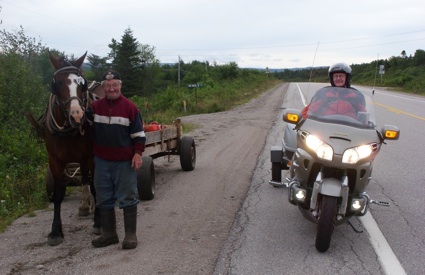I was born on Prince Edward Island and the Atlantic Provinces are very dear to me. It was emotional when I entered New Brunswick. The sight of the lush Saint John River Valley, hydroelectric dams, fishing villages, boats and the smell of the salt air from the ocean was imminent. I was apprehensive and excited!
I received a rude wake-up call at 2:30 a.m. during my first night tenting in Northern New Brunswick. Something was rummaging within inches of my tent. I could hear the rustling of paper and plastic. After a few adrenalin-filled moments, I realized the animal was small and I had nothing to fear. Was it a porcupine or raccoon? Flashlight in hand, I bravely unzipped the tent and lit up the business end of a skunk. I retreated and didn't move until the perfume-rendering creature left.
Nestled in the Saint John River Valley is Hartland, home to the world's longest covered bridge, constructed entirely of wood and covered for longevity. I passed through Fredericton and wound my way along the river, bypassed Moncton and rode through the Sackville and Tantramar marsh area as I neared Nova Scotia. This was to be my first taste of sea air.
A sensational city
My wife Judy surprised me and bought a plane ticket to meet me in Halifax. That city is sensational! It is difficult to fathom that Halifax was devastated by a munitions ship explosion many years ago. It is a beautiful port city and the harbour front was bustling with activity—container ships, navy frigates, a submarine being refitted, pleasure crafts and acres of import autos awaiting delivery after arriving by sea. During low tide, I watched dozens of clam diggers and children on a sand bar.
Judy and I headed to P.E.I. and were subjected to sensory overload. The Confederation Bridge, at 13 kilometres long, connects New Brunswick to Prince Edward Island, and is the world’s longest bridge over ice-covered water. Its distinct hump in the middle, the navigation span for ships, towered in the distance. As we neared Charlottetown, I was captivated by the sight of the bright red and orange soil on the shoreline and the potato fields.
Charlottetown is quaint and delightful, with endless ocean views. Victoria Park, with its views and boardwalk, is a must-see. Lobster sandwiches are available as fast food and I gorged on shellfish many times. Cruising the north shore, home to Anne of Green Gables and a multitude of world-class beaches, is a necessity.
Swapping stories
My stepfather, Bruce, a long-removed Newfoundlander, joined me on P.E.I. He had a boyish grin and a twinkle in his eyes when he climbed aboard my motorcycle, and I knew we were doing the right thing. We were pumped as we headed to "The Rock". There would be four ferry rides before we returned to P.E.I. During the ride to Fort Louisbourg and then Port aux Basques, Bruce gained his motorcycle sea legs. The Fortress of Louisbourg on Cape Breton Island is spectacular. The ferry terminal to Newfoundland in North Sydney was minutes away, and we had some great chats with strangers. They were intrigued by our Alberta license plate and plans, but more so by Bruce's plans. It was heartwarming to watch Bruce explaining his adventure and intentions to revisit the land of his birth to the inquisitive motorists.
The Newfoundland mountain ranges are vast, rugged and untouched. We rode north out of Channel Port aux Basques early the next morning, nestled in between the Anguille Mountain Range and the Long Range Mountains. The air was fresh and coastal. We stopped and chatted with a fellow driving a horse and wagon on the side of the road. Dale lived nearby and said his horse, Mutt, “was easy on gas." Dale didn't seem to have a care in the world.
The ride through Gros Mourne National Park and the coastal drive heading to St. Anthony, the farthest point northwest on the island, is spectacular. We were privy to the sight of five moose, once having to stop abruptly when a moose crossed the road in front of us, hooves clopping. There was a sign stating that there had been 660 vehicle-moose collisions in 2010 alone. We hugged the coastline where the wind and rain were, at times, inhospitable. The town of Port aux Choix was our host for the night. We ate brimming bowls of fresh seafood chowder and enjoyed a view of the harbour and fishing boats. We were taken aback by the strength of the winds coming off the ocean.
Taste the salt air
It was unimaginable when we reached the end of the line. At St. Anthony we were within spitting distance of the North Atlantic and I could taste the salt air. The road ended abruptly with a small turnaround and a lighthouse. The view there was life-changing. It made me realize we are all just here on borrowed time.
There is only one road to St. Anthony. During our return, we tented inland away from the rigors of the ocean, overlooking a lake in the small town of Howley. The sunset was incredible and the locals friendly. We awoke to the lonely call of a loon on the lake. Further down the road in Gander, we visited the Aircraft Museum and a memorial at the site where a US military aircraft crashed in the early 80s. Hundreds died; it is reportedly the worst air disaster in Canadian history.
St. John's, mile 0 for the Terry Fox Marathon of Hope, is a large, modern city on the eastern tip of Newfoundland reaching out into the Atlantic. The panoramic views from Signal Hill are unforgettable. This National Historic Site was reportedly used for coastal defenses, and there is a placard acknowledging Signal Hill as being the reception point for the first transatlantic wireless signal.
I was intrigued with the small garden plots along the highway that seemed to be in the middle of nowhere. The locals told me it was because you can't just plant a garden anywhere on The Rock. The soil tilled up around power lines and similar areas is host to many a small garden.
The home stretch
There is only one road to St. John's and our return to the ferry terminal was to be more of the same. We made better time than expected, allowing for a spectacular side trip through Stephenville and around the Port au Port Peninsula. Stephenville has past US military ties and there was a US fighter jet on display, along with many airport hangars from years gone by. Visiting Port au Port Peninsula and St. George's Bay was profound; a map simply does not do it justice. A local stopped in traffic beside us and asked if we were going to ride the peninsula, and led us to the best route to start this grand adventure. We inched our way around the coastline. It is dotted with fishing villages, vistas, mountainous climbs and small islands. Unfortunately, we couldn’t stay long as we had a date with a car ferry. We spotted Dale and Mutt on the highway again, and exchanged waves as we passed.
After I dropped Bruce off on P.E.I., I recharged for the long trek back west. I felt sad to leave. On my way north, I rode through Algonquin Provincial Park. The panoramic views and the folks on countless lakes boating, canoeing and fishing in the Muskoka Region in central Ontario was breathtaking. I watched two moose feeding by the road.
It is not possible in so few words to describe the beauty of Canada. The views from start to finish were captivating, there were so many photo opportunities and the kindness of strangers was unexpected. I have grown up in a different era and sympathetic to the new generation. They appear to be caught up with their wireless gadgets and seem to be oblivious to life around them, though I hope this is not the case. Many times during this trip, I just turned off the music.
I’ll finish with a line I read in Travels with Charley by John Steinbeck: "You do not take the trip, the trip takes you." I agree and I like where it took me.








Comments